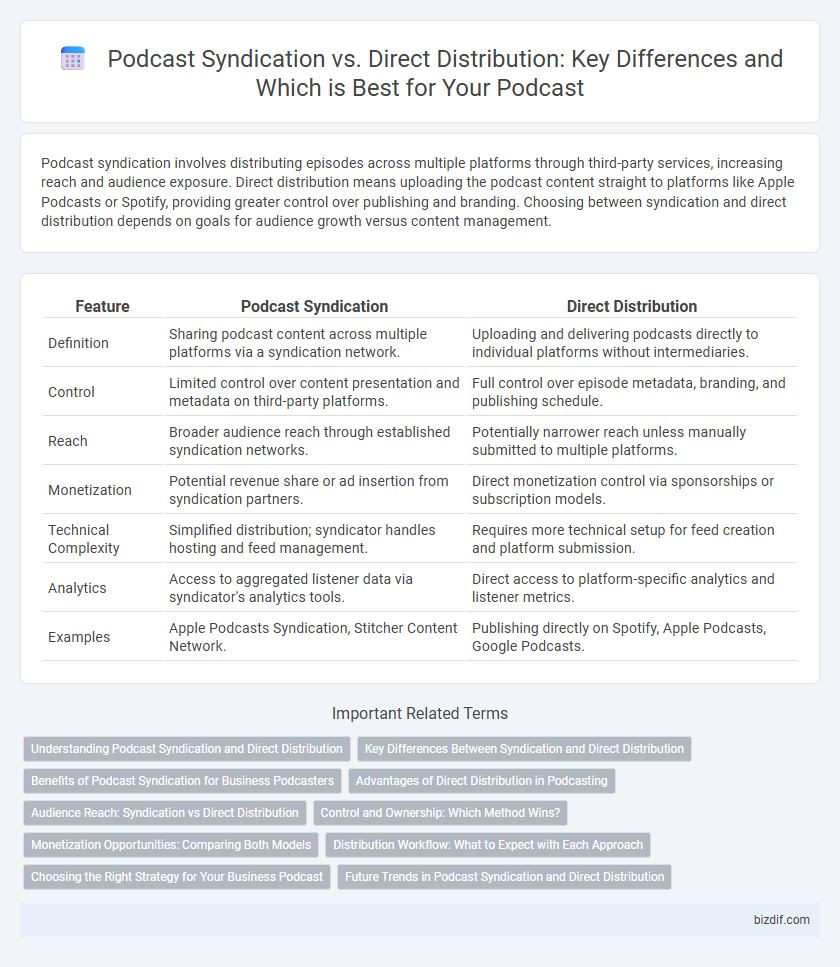Podcast syndication involves distributing episodes across multiple platforms through third-party services, increasing reach and audience exposure. Direct distribution means uploading the podcast content straight to platforms like Apple Podcasts or Spotify, providing greater control over publishing and branding. Choosing between syndication and direct distribution depends on goals for audience growth versus content management.
Table of Comparison
| Feature | Podcast Syndication | Direct Distribution |
|---|---|---|
| Definition | Sharing podcast content across multiple platforms via a syndication network. | Uploading and delivering podcasts directly to individual platforms without intermediaries. |
| Control | Limited control over content presentation and metadata on third-party platforms. | Full control over episode metadata, branding, and publishing schedule. |
| Reach | Broader audience reach through established syndication networks. | Potentially narrower reach unless manually submitted to multiple platforms. |
| Monetization | Potential revenue share or ad insertion from syndication partners. | Direct monetization control via sponsorships or subscription models. |
| Technical Complexity | Simplified distribution; syndicator handles hosting and feed management. | Requires more technical setup for feed creation and platform submission. |
| Analytics | Access to aggregated listener data via syndicator's analytics tools. | Direct access to platform-specific analytics and listener metrics. |
| Examples | Apple Podcasts Syndication, Stitcher Content Network. | Publishing directly on Spotify, Apple Podcasts, Google Podcasts. |
Understanding Podcast Syndication and Direct Distribution
Podcast syndication involves distributing podcast episodes through third-party platforms or networks, enhancing reach by leveraging established audiences and multiple directories. Direct distribution occurs when creators upload episodes directly to hosting platforms or websites, maintaining complete control over content and audience engagement. Understanding the differences helps podcasters optimize their distribution strategy for growth, analytics, and monetization opportunities.
Key Differences Between Syndication and Direct Distribution
Podcast syndication involves distributing podcast episodes through third-party platforms and aggregators, allowing wider reach and automated content sharing across multiple channels. Direct distribution requires podcasters to upload episodes manually to individual platforms or host-specific websites, providing greater control over content and audience data. Syndication emphasizes broad exposure and ease of dissemination, whereas direct distribution focuses on ownership and tailored audience engagement.
Benefits of Podcast Syndication for Business Podcasters
Podcast syndication amplifies business podcasters' reach by distributing episodes across multiple platforms, increasing audience exposure and engagement. Syndication streamlines content delivery, allowing host companies to maintain consistent branding while tapping into diverse listener bases. This method improves SEO rankings and drives higher traffic to the primary podcast site, boosting potential revenue streams and advertiser appeal.
Advantages of Direct Distribution in Podcasting
Direct distribution in podcasting enhances control over content delivery, allowing creators to manage episodes, metadata, and updates without relying on third-party platforms. This approach improves audience engagement by providing seamless access through dedicated apps or websites, fostering stronger listener relationships and brand loyalty. Moreover, direct distribution offers better monetization opportunities, as podcasters can implement customized advertising and subscription models without platform-imposed restrictions.
Audience Reach: Syndication vs Direct Distribution
Podcast syndication enables content to be distributed across multiple platforms and networks, significantly expanding audience reach by tapping into diverse listener bases. Direct distribution limits reach to the specific channels or apps where the podcast is uploaded but allows for more control over branding and listener engagement. Syndicated podcasts benefit from enhanced discoverability through aggregated platforms, while direct distribution relies heavily on targeted marketing and loyal audience followership.
Control and Ownership: Which Method Wins?
Podcast syndication offers creators broader reach by allowing distribution through multiple platforms, but often involves relinquishing some control over content presentation and monetization. Direct distribution empowers podcasters with full ownership, enabling personalized audience engagement, custom branding, and direct monetization strategies without intermediary limitations. For podcasters prioritizing control and ownership, direct distribution stands out as the superior method, preserving creative freedom and revenue potential.
Monetization Opportunities: Comparing Both Models
Podcast syndication leverages established networks to amplify reach and offers monetization through ad revenue sharing, sponsorship deals, and cross-promotion opportunities. Direct distribution provides podcasters full control over content and revenue streams, enabling premium subscriptions, exclusive content sales, and direct advertising partnerships. Evaluating podcast syndication versus direct distribution reveals distinct monetization pathways that align with varied audience scale and branding strategies.
Distribution Workflow: What to Expect with Each Approach
Podcast syndication involves distributing episodes through third-party platforms that aggregate and share content, simplifying reach across multiple channels and increasing exposure. Direct distribution requires podcasters to manually upload and manage episodes on individual platforms, offering greater control over metadata and audience analytics. Understanding these workflows helps creators choose between ease of scale with syndication or personalized management with direct distribution.
Choosing the Right Strategy for Your Business Podcast
Podcast syndication offers broader audience reach by distributing your episodes across multiple platforms, increasing discoverability and engagement metrics. Direct distribution provides greater control over content delivery and analytics, allowing businesses to tailor listener experiences and optimize marketing strategies effectively. Selecting the right approach depends on balancing the need for wide exposure with the desire for detailed audience insights and brand consistency.
Future Trends in Podcast Syndication and Direct Distribution
Future trends in podcast syndication and direct distribution emphasize increased automation and AI-driven content personalization to enhance listener engagement. Syndication platforms are expected to leverage blockchain technology for transparent royalty management, while direct distribution will prioritize integrated monetization options and seamless multi-channel publishing. Advances in 5G and edge computing will further optimize streaming quality and enable real-time analytics for podcasters, shaping the next generation of content delivery.
Podcast Syndication vs Direct Distribution Infographic

 bizdif.com
bizdif.com